Asking how far can you drive on a spare tire must mean you own one of the few cars with a spare tire supplied from new. Which is lucky, but you probably have a puncture that is not so fortunate.
To get straight to it, most spare tires have warning stickers indicating the mileage and speed limitations; however, there are occasions when you can ignore this, which is explained in this article.
Full Size Spare Wheel and Tire
You might see a full-size spare rim and tire with a sticker warning you that you can only carry out reduced speed; however, this is not the case. You may be able to carry on at normal speeds. You can even permanently keep that wheel fitted to the car if it’s a matching wheel and tire. Although it may not have a TPMS valve fitted, in which case, it needs to go back in the trunk as the spare. It happens often, so it’s worth checking with your mechanic if you’re unsure who can confirm if it is a full-size spare.
The reason it comes with this warning sticker is the spare tires and wheel are made on mass. Until the car is decided on its final specs, it may have bigger alloy rims fitted. Imagine you have a 16-inch rim on the front right, and the spare is a 14-inch steel rim fitted to the passenger front. Driving at high speeds could result in diff/transmission-related problems because the rolling radius may not be the same.
In this instance, you should only carry out 50 miles at 50mph. Although it’s possible to do more because it is a proper tire, you should keep the speed down and limit the amount of driving until you can replace the flat tire.
But another variant of the same car may come with the same 14-inch wheel and tires on all four corners of the vehicle, which is no different with the full-size spare tire fitted.
Space Saver (Donut Wheel)
The donut wheel, space saver, or compact spare goes by many different names; the tire and wheel are much larger in diameter, lower profile, and has a much thinner tire than the original wheel. They are only designed to do a maximum of 50 miles at 50 mph. Tires are designed with a speed rating, a limit to what the tire can handle, and space-saver tires have the lowest speed ratings.
Do not think that driving at 51mph and the space saver spare will blow up and shred because that is not the case. But start to creep up to 60+ mph, and you risk causing an issue for yourself.

Risks of Driving Long Distances on the Space Saver
The problem with driving long distances on the donut wheel is that the rim and tire are not designed to handle high heat. When traveling long distances, the heat will rise in the wheel and tire regardless of keeping the speed down. A very hot tire becomes weak, which can cause a bulge or puncture easily.
Hence, manufacturers recommend you carry out no more than 50 miles at 50 miles per hour. It is not because the tire is worn out because it goes back in the trunk ready for the next time you are unlucky to get another flat tire; it is because the tire cannot handle the heat generated because of the reduced plys constructed in the tire. After all, you will only use this tire in an emergency.
If you have to carry out lots of miles on the spare tire to get you home, make regular stops to allow the tire to cool down before continuing on your journey again. This will limit the probability of a problem arising.
How Many Times Can You Reuse the Spare Tire?
The spare tire is safe to reuse as much as required, provided it is still above the legal limit. Just because the spare is fitted in an emergency does not mean it is exempt from any rules.
It would be best if you regularly check the tire treads alongside the tire pressure on the spare tire to ensure it is in good condition when required.
Conclusion
You can drive on a space saver spare tire for 50 miles at 50 mph. It is not recommended that you exceed 50 miles because the rising heat in the tire can cause the tire to puncture. It is worth noting if you have a full-size spare before getting to the point of an emergency so that you know if you can carry on as usual or not.









